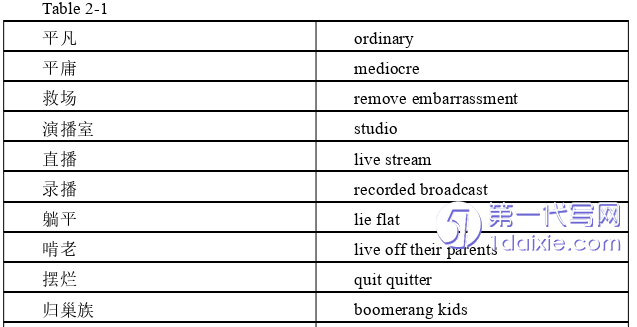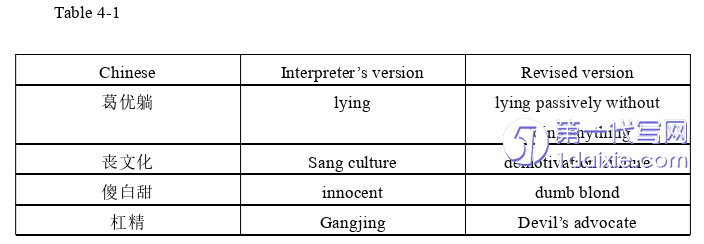本文是一篇英语毕业论文,本文是在释意理论的指导下进行的,国内外的诸多学者对释意理论进行了大量的理论研究,但是为数不多的研究是结合理论与具体的任务进行探讨的。
Chapter One Task Description
1.1 Background of the Task
The target audience of the speech is young students.As a journalist,Kang Hui alwayswalks in the front line of hot topics.He is familiar with hot words and current affairs,can getclose to the people,listens to the voices of the people,and feels and understands youngpeople’s confusion.Such sincere speech represented by Kang Hui is worth spreading.Besides,Kang Hui’s speech can give more people exposed to some positive energy andinspirational ideas,which can alleviate the anxiety for students who are about to graduate.What’s more,the three-year pandemic also affects people,including young people in manyaspects.Under dual pressure presented by the pandemic and graduation,listening to somespeeches with positive energy is relaxing and useful.
Besides,simultaneous interpreting enables more people to listen to the motivationalspeech firsthand,and is helpful to let these ideas transcend national boundaries and affectmore people so that the world can also understand some of our Chinese ideas.That’s why theauthor chooses this speech as an interpreting task.
1.2 Requirements of the Task

The task requires the interpreter to have some background information of the task,including the speaking style and experiences of the speaker and the target audience.Besides,this task requires the interpreter has a good master of both English and Chinese and canconvert these two languages smoothly and follow the speaking speed of the speaker.The lastis the ability to deal with pressure.These requirements include both the requirements of thelanguage proficiency and the psychological quality.
Chapter Two Task Process
2.1 Pre-interpreting
Preparation before the interpreting is important since interpreting is unpredictable tosome degree.Preparation can be divided into long-term preparation and short-termpreparation.Long-term preparation refers to the interpreter’s bilingual competence whichcomes from daily accumulation,including vocabulary,memory,listening,and background.Short-term preparation refers to the preparation of several days,weeks,or months before thetask,including preparing some terms,the topic,background,target audience,and speaker.This chapter is about the short-term preparation before the interpreting and is divided intothree parts,task background,features of the material,and the glossary preparation.
2.1.1 Preparation for Background Information
The task is to finish the on-site Chinese-English simultaneous interpreting of the47-minute speech delivered by a host in CCTV,Kang Hui,who hosts some famous programssuch as the CCTV news,Eastern Times.The target audiences is young students,includingthose going to graduate from the university.The topic is“ordinariness is not equal tomediocrity”,which is relevant to young people.
2.2 While-interpreting
The whole process is recorded for better reflection after the interpreting.Besides,audiences are invited to the practice,corresponding devices are in place.
The interpreter only gets one chance to interpret in the real task.The whole processrequires intense concentration to ensure the completion of the task.Pressure is inevitable,however,overcoming such stress is part of the interpreter’s task.Getting rid of pressure butfocusing more on the interpreting itself is something the interpreter has to do whileinterpreting,such motivation comes from our confidence in our ability and our determinationto better perform our task.Such ability comes from our daily accumulation and practice.Such motivation lies in our faith in interpreting and responsibility.When it comes to a senseof responsibility,it is enshrined in Kang Hui’s speech.In the interpreting process,it isimportant to stay calm and focus on the interpreting of the speech itself,we are no more astudent to be judged by our gentle teacher,but a professional interpreters who interpret forthe customer and we are responsible for the audience to convey actual meaning to them.
Chapter Three Principle, Strategy and Technique ..................... 7
3.1 Interpretive Theory ...................................... 7
3.2 Relations between Principle, Strategy and Technique ....................... 9
Chapter Four Problems and Solutions ................................ 11
4.1 Buzzwords ......................... 11
4.1.1 Addition ...................................... 12
4.1.2 Explanation ....................................... 12
Conclusion ............................... 21
Chapter Four Problems and Solutions
4.1 Buzzwords
Chen Zexing(2021:258)defines hot words as“the words popular on the Internet,whichare related to people’s daily life and hot topics”.Li Tiechui(2012:23)regards them as“semantic expressions that are recognized,sought and widely spread by netizen”.They havethree features:“fragmented but fast transmission;diversified sources and strong sense ofreality;bottom-to-up spread in the grassroots”(Shen,Wang,Zhong,2021:50).With theprevailing of the Internet,the interpreting of hot words is a double-edged sword.As Zhouyi,Wang Jiayu and Zhao Yufan(2023:93)said“each participant should maintain and purify thenetwork language environment.For translators or interpreters,they should be cautious aboutthe hot words interpreting”.Tan Ning(2014,158)said“It is more important to translate thedeep meaning hidden because that is the reason why they are coined”.
In Kang Hui’s lecture,there are some buzzwords with profound meaning.Accurate andprompt interpreting is challenging for the interpreters,which requires not only a quickresponse but also daily accumulation.The table below shows the buzzwords mentioned inthe case analysis.

Conclusion
This report is made under the guidance of Interpretive Theory.Many scholars at homeand abroad have done a lot of theoretical research on Interpretive Theory,however,fewstudies are combined with specific interpreting practice.Guided by the Interpretive Theory,Communicative Strategy and related techniques,the author analyzes the hot words,information redundancy and loose sentences of the text and puts forward the correspondingsolutions.
The author puts forward corresponding solutions to three kinds of problems in thereport:interpreting hot words,information redundancy and loose sentences.The interpretingof hot words applies techniques like addition and explanation.Omission and informationreconstruction are used to deal with the problems of interpreting information redundancy andloose sentences.Through these case analyses,the author concludes that Interpretive Theory,Communicative Strategy and corresponding techniques like addition,omission andreconstruction can provide guidance for interpreting.Interpretive Theory guides theinterpreter to jump out of the words to grasp the actual meaning.Communicative Strategyrequires the interpreter to make the effect of the target text on the listeners of the targetlanguage the same as that of the original text on the listeners of the source language.Toachieve the goals of the Interpretive Theory and Communicative Strategy,the interpreterneeds to adopt some techniques.Such a process between practice and principle,strategy andtechnique is a complementary one.
reference(omitted)
